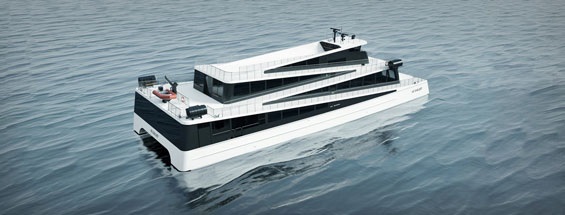Futuristic Hybrid Ferry for Norwegian Fjords
Construction of a new hybrid passenger ferry destined for the Norwegian fjords is underway. The vessel’s concept has been named Seasight by shipbuilder Brødrene Aa.
The ferry will carry up to 400 tourists between Flåm and Gudvangen along the Nærøyfjord in the west of Norway, a distance of around 32 km. Once it has arrived in the most scenic part of the fjord it will switch to battery power, allowing sightseers to enjoy nature in almost complete silence at around 10 knots.
The fjord is on UNESCO’s World Heritage List because it remains largely unspoilt by human development, and the ferry is designed with the surroundings in mind.
Seasight will complete around 700 journeys a year for its owner, The Fjords, from May 2016.
The ferry design is inspired by a trail finding its way up a steep mountainside. It measures 40 meters in length and 15 meters in width. Outside the ferry, passengers will be able to climb all over the boat while the inside will feature panoramic views and 450 seats.
The construction of the carbon fibre vessel is already underway at Brødrene Aa, which also came up with the concept. Anstein Aa from Brødrene Aa says, “This is one of the most exciting vessels we have ever constructed in terms of both aesthetics and technology.”
ABB will supply a compact and lightweight version of its award winning Onboard DC Grid system that will manage and control the energy flow between the diesel engine, propeller and charging station. The Onboard DC Grid is a key enabler in efficiently integrating energy storage into modern marine power systems through its DC infrastructure and integrated power and energy management system. In the case of the Seasight, the Onboard DC Grid will transfer energy to the battery during charging, which will happen at both ends of the voyage, and whilst the diesel engines are running.
ABB has already engineered the technology to allow larger passenger ferries, including those which carry cars, to run on hybrid or pure battery power. The environmental saving in terms of carbon dioxide reduction for just one vessel can be the equivalent to electrifying thousands of cars.
“Regulation means Norway is leading the world in terms of battery power for passenger ferries,” commented Sindre Sætre, ABB’s Director of Marine and Ports in Norway. “Globally battery power and hybrid technology is gaining importance in the maritime sector and we are delighted to be at the forefront of that process.”
Specification
Length: 40m
Width: 15m
Materials: Carbonfiber sandwich
Seats: 450
Class: DNV light craft
Main engine: 2 x 250kw el. motor(PM)
Propulsion: Propeller
Generator: 300kW Scania
Battery pack: 500kWh

